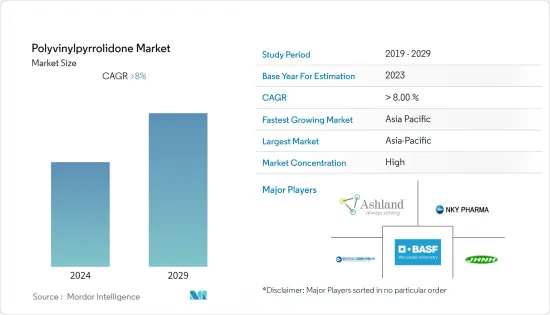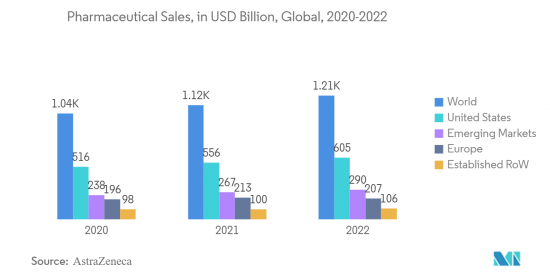PUBLISHER: Mordor Intelligence | PRODUCT CODE: 1406067

PUBLISHER: Mordor Intelligence | PRODUCT CODE: 1406067
Polyvinylpyrrolidone - Market Share Analysis, Industry Trends & Statistics, Growth Forecasts 2024 - 2029

The global polyvinylpyrrolidone market is estimated to be at 80,562.98 tons by the end of this year and is projected to reach 119,088.58 tons in the next five years, registering a CAGR of over 8% during the forecast period.
During the outbreak of the COVID-19 pandemic, demand for polyvinylpyrrolidone declined due to reduced demand from end-user applications. Prolonged lockdowns worldwide resulted in labor shortages and supply chain disruptions in the construction segment, affecting the demand for adhesives that find major applications in the segment. Furthermore, with strict restrictions on people's movement, retail sales for packaged and fast food, cosmetics, and personal care products slumped during the pandemic. On the flip side, the continued growth of the pharmaceutical industry slightly improved the demand for polyvinylpyrrolidone in pharmaceutical applications. However, with the manufacturing sector now fully restored to pre-pandemic levels of activity, demand for polyvinylpyrrolidone is anticipated to grow steadily during the next several years.
Key Highlights
- Polyvinylpyrrolidone is extensively used in the pharmaceutical industry as a binder in the manufacturing of tablets. With major economies across the globe spending on developing the pharmaceutical industry in the aftermath of the pandemic, the demand for the studied market is projected to experience strong growth in the segment.
- Furthermore, growing construction activities across the globe, in view of rising demand for residential and commercial construction, are anticipated to further boost demand for polyvinylpyrrolidone.
- However, the studied market could likely be affected by the presence of substitute products that can potentially replace polyvinylpyrrolidone across various applications.
- On the flip side, an increasing application scope in the personal care and cosmetics industry may present future growth opportunities for the studied market.
- Asia-Pacific dominated the market and is expected to continue its dominance during the forecast period, major supported by the extensive growth of the pharmaceutical segment in the region.
Polyvinylpyrrolidone Market Trends
Rising Demand in the Pharmaceutical Industry
- Polyvinylpyrrolidone or PVP can be used in medical and health fields as a binder, excipient, coating, bounded solution of an agent, cosolvent, sterilization disinfectant, solubilizer, sustained release agent, capsule shell, dispersion stabilizer, others due to its excellent solubility, solubilization property, bonding capacity, complexing power, and other functions.
- The pharmaceutical industry and medicine are the earliest and probably the most well-known areas to have benefited from PVP due to its extraordinary biocompatibility and ability to create stable association compounds and complexes with various active substances.
- China, India, the United States, and Germany are the largest pharmaceutical industries in the world. It is estimated that Chinese manufacturers make up around 40% of all the APIs used worldwide. Additionally, China and India are the sources of 75% to 80% of the APIs imported to the United States. The desire for cost savings and less stringent environmental regulations has been driving the pharmaceutical industries in China and India.
- According to AstraZeneca, the projected pharmaceutical sales in 2024 are expected to be USD 633 billion for North America holding the major share, followed by the European Union (excluding the United Kingdom) with USD 287 billion at the second position, then Southeast and East Asia expected to register USD 232 billion.
- The pharmaceutical sector is one of the major industries in the United States and one of the country's most research and development-intensive industries. According to AstraZeneca, the pharmaceutical industry in the United States is the largest globally, accounting for 49.8% of global pharmaceutical sales in 2022, with sales amounting to USD 605 billion.
- The United States' expanding and aging population is fuelling the expansion of the pharmaceutical industry. Moreover, 15% of the population in the United States is over 65, and this percentage is predicted to expand by 2023.
- According to the Association of the British Pharmaceutical Industry (ABPI), the annual turnover of the United Kingdom's pharmaceutical industry is estimated at around EUR 50.21 billion (USD 58.36 billion). Some of the key players in the market include GlaxoSmithKline and AstraZeneca. Furthermore, the country is one of the major exporters of life-saving drugs to patients across the world.
- In 2022, the United Kingdom exported EUR 25.4 billion (USD 29.52 billion) worth of pharmaceutical and medicinal products around the world and imported around EUR 30.8 billion worth of products, with the trade deficit standing at approximately EUR 5.4 billion (USD 6.28 billion).
- Such trends in the pharmaceutical industry are anticipated to augment demand for the studied market during the forecast period.

Asia-Pacific Region to Dominate the Market
- The Asia-Pacific region is expected to dominate the market for polyvinylpyrrolidone during the forecast period. In countries like China, India, and Japan, the demand for polyvinylpyrrolidone has been increasing in the region due to the growing pharmaceutical industry.
- In China, polyvinylpyrrolidones (PVP) are widely adopted as a safe binder and blood plasma expander in the pharma industry. The pharmaceutical industry in China is one of the largest in the world. The country produces generics, therapeutic medicines, active pharmaceutical ingredients, and traditional Chinese medicine.
- More than 90% of the drugs registered in the country are generic. The government has implemented the "Healthy China 2030" initiative for developing the healthcare industry, which aims for the market to reach a value of USD 2.4 trillion by 2030.
- According to a report by Invest India, the pharmaceutical industry in India is anticipated to reach a market value of USD 65 billion by the year 2024, with further growth projected to reach USD 130 billion by 2030. This is anticipated to increase the production of pharmaceutical goods and, thereby, is likely to benefit the market demand in the country.
- India ranks 3rd worldwide for production by volume and 14th by value. The Indian pharmaceutical sector contributes about 2% to India's GDP and around 8% to the country's total merchandise exports.
- On the other hand, according to the India Brand Equity Foundation, the food service market in India was estimated to be nearly USD 41 billion in 2022. Quick-service restaurants accounted for a large value of the market. In terms of segments, the unorganized sector dominated the food service industry, even though the organized market has a significant year-on-year growth.
- The revenue from the food industry has been growing significantly and is projected to grow to USD 1,163.19 billion in 2025, as per the study. Moreover, the Indian frozen food market is expected to grow by 17% from 2019 to 2024, according to the Indian Council of Medical Research (ICMAR), thereby potentially augmenting demand for the studied market in food applications.
- According to the US Department of Agriculture (USDA), the Japanese food industry produced food valued at USD 190 billion in 2022, declining by 12.4% in comparison to 2021. However, an increase in production was seen in alcoholic beverages, soft drinks, fish products, and other health food categories.
- To facilitate the growth of the cosmetic industry, the Japan Cosmetic Industry Association (JCIA) was established in April 2023 by integrating the Tokyo Cosmetic Industry Association, the Japan Cosmetic Industry Federation, the West Japan Cosmetic Industry Association, and the Chubu Cosmetic Industry Association.
- Thus, the factors above indicate a growing demand for polyvinylpyrrolidone in the region during the forecast period.
Polyvinylpyrrolidone Industry Overview
The polyvinylpyrrolidone market is consolidated in nature. The top five players account for a major share of the market. Major companies in the market include BASF SE, Ashland, Boai NKY Pharmaceuticals Ltd., Sichuan Tianhua Chemical Group Co., Ltd., and JH Nanhang Life Sciences Co., Ltd, among others.
Additional Benefits:
- The market estimate (ME) sheet in Excel format
- 3 months of analyst support
TABLE OF CONTENTS
1 INTRODUCTION
- 1.1 Study Assumptions and Market Definition
- 1.2 Scope of the Study
2 RESEARCH METHODOLOGY
3 EXECUTIVE SUMMARY
4 MARKET DYNAMICS
- 4.1 Drivers
- 4.1.1 Rising Demand in the Pharmaceutical Industry
- 4.1.2 Growing Application as Adhesives in the Construction Industry
- 4.2 Restraints
- 4.2.1 Presence of Substitutes
- 4.3 Industry Value Chain Analysis
- 4.4 Porter's Five Forces Analysis
- 4.4.1 Bargaining Power of Suppliers
- 4.4.2 Bargaining Power of Consumers
- 4.4.3 Threat of New Entrants
- 4.4.4 Threat of Substitute Products and Services
- 4.4.5 Degree of Competition
5 MARKET SEGMENTATION (Market Size in Volume)
- 5.1 Form
- 5.1.1 Powder
- 5.1.2 Liquid
- 5.2 Application
- 5.2.1 Pharmaceutical
- 5.2.2 Food and Beverage
- 5.2.3 Cosmetics
- 5.2.4 Adhesives
- 5.2.5 Other Applications
- 5.3 Geography
- 5.3.1 Asia-Pacific
- 5.3.1.1 China
- 5.3.1.2 India
- 5.3.1.3 Japan
- 5.3.1.4 Rest of Asia-Pacific
- 5.3.2 North America
- 5.3.2.1 United States
- 5.3.2.2 Canada
- 5.3.2.3 Mexico
- 5.3.3 Europe
- 5.3.3.1 Germany
- 5.3.3.2 United Kingdom
- 5.3.3.3 Italy
- 5.3.3.4 France
- 5.3.3.5 Rest of Europe
- 5.3.4 South America
- 5.3.4.1 Brazil
- 5.3.4.2 Argentina
- 5.3.4.3 Rest of South America
- 5.3.5 Middle-East and Africa
- 5.3.5.1 Saudi Arabia
- 5.3.5.2 South Africa
- 5.3.5.3 Rest of Middle-East and Africa
- 5.3.1 Asia-Pacific
6 COMPETITIVE LANDSCAPE
- 6.1 Mergers and Acquisitions, Joint Ventures, Collaborations, and Agreements
- 6.2 Market Share (%) Analysis
- 6.3 Strategies Adopted by Leading Players
- 6.4 Company Profiles
- 6.4.1 Ashland
- 6.4.2 BASF SE
- 6.4.3 Boai NKY Pharmaceuticals Ltd.
- 6.4.4 Glide Chem Private Limited
- 6.4.5 Hangzhou Motto Science & Technology Co. Ltd.
- 6.4.6 JH Nanhang Life Sciences Co. Ltd.
- 6.4.7 Nippon Shokubai Co. Ltd.
- 6.4.8 Shanghai Qifuqing Material Technology Co. Ltd.
- 6.4.9 Shanghai Yuking Water Soluble Material Tech Co. Ltd.
- 6.4.10 Sichuan Tianhua Chemical Group Co. Ltd.
- 6.4.11 Thermo Fisher Scientific Inc.
- 6.4.12 Zhangzhou Huafu Chemical Co. Ltd.
7 MARKET OPPORTUNITIES AND FUTURE TRENDS
- 7.1 Increasing Application Scope in the Personal Care and Cosmetic Industry
- 7.2 Other Opportunities




